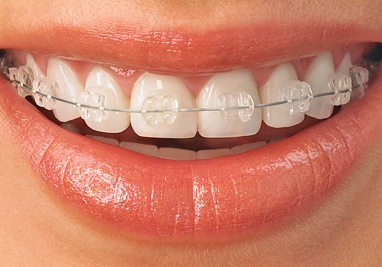Braces
Braces are hi-tech appliances that are temporarily attached to teeth. By attaching a modern wire to them, a force is applied in a controlled manner to move the teeth within the jaw bone. Thankfully modern-day braces are sleek and aesthetic.
WSO uses the latest technologies, including self-ligating brackets, heat-activated nickel-titanium wires, ceramic brackets, and digital 3-Dimensional virtual set-ups, to achieve the best possible treatment outcome as comfortably and quickly as possible.
Life is all about choice, and we offer our patients choices in their braces. You can choose from silver, champagne, or clear ceramic braces, and can pick whether you want bright-coloured elastics or no visible colours.
We’ll review the different types of braces with you in more detail when you come in for your initial complimentary consultation at West Shore Orthodontics. We’re always proud to showcase the latest advancements in orthodontics to our patients!
Questions about braces;
Protocols For Orthodontic Emergencies
A true orthodontic emergency is rare however when they do occur, we are available to help you. If you experience severe, persistent pain or discomfort relating to your braces, aligners, or appliance, please call our office. We will either guide you over the phone on how to resolve the issue or we will schedule an office visit to assist you further.
You may be surprised and relieved to know many orthodontic problems can be resolved by you at home, at least temporarily until we can see you in our office. Your comfort is very important to us and managing that first and foremost is key. After alleviating your discomfort, it is very important you call us as soon as possible to schedule an office visit to evaluate and resolve the issue. A disruption in treatment time may occur if your damaged braces/aligner/appliance are not resolved in a timely manner.
Major Problems
Major Orthodontic problems include;
-
- Trauma or injury to the teeth, face, or mouth
- Infection or swelling of the gums, mouth, or face
- Severe, persistent, unmanageable discomfort, pain, or bleeding in these areas
If any of these situations occur seek help as soon as possible! Please call our office or a general dentist. As a last resort, head to your nearest walk-in clinic or hospital emergency department.
Fortunately, most orthodontic problems are minor, though they may still cause significant discomfort or irritation to your gums, cheeks, lips, tongue and teeth. Here are a few of the more common orthodontic problems, along with some tips on how you can achieve relief at home. →
Handling Minor & Common Issues
Loose bracket or band
If your bracket or band is still attached to the wire, you should leave it in place and put wax on it for comfort. If the bracket or band can be removed easily, place it in an envelope and bring it to your next appointment.
Loose wire
If a wire is out of the bracket or band and is loose or bulging, use a pair of tweezers or needle-nosed pliers to put your wire back into place or in a more comfortable position (Clean and disinfect tweezers/pliers with rubbing alcohol, or 3% hydrogen peroxide or thoroughly wash with soap and water before placing in the mouth).
You can’t do anything we can’t undo. Your comfort is key. If you cannot put the wire into a comfortable position and covering the end with wax doesn’t help, as a last resort you can use a small disinfected fingernail clipper. Clip the wire behind the last tooth to which it is securely fastened. If the end of the wire where you trimmed is sharp, place wax on it. If one of the colored elastics is missing, you can use a piece of floss to tie the wire into place.
Poking wire
Using a pencil eraser or the back of a spoon, push the poking wire down or place wax on it so that it is no longer poking.
Poking appliance
The lips, cheeks and tongue may become irritated for one to two weeks after treatment begins as they adapt to the new changes and positions. If the appliance is poking, apply wax as necessary and call our office for further instruction.
Lost or broken appliance
If you have lost or broken your appliance, please call the office. We may want to see photos of the broken appliance to see if it can be repaired. If the appliance is lost, we will let you know what the next steps are to get you a replacement.
Lost or broken retainer or Invisalign aligner
If you have lost or broken your retainer, please call the office. If you have lost or broken your Invisalign Aligner, you have two options.
- You can try to move forward to the next aligner, it will probably be tight so consider 2-3 weeks wear of this stage.
- If it does not fit, please call the office to let us know and go back to your previous aligner until your new one arrives.
TMJ or jaw joint pain
If you suffer from pain in your jaw that you suspect is from your orthodontic treatment, we recommend over-the-counter analgesic medications as needed as well as a 20-minute warm compress alternating with a 20-minute cold compress. If you are in aligners and the discomfort does not subside, you can try to go to nighttime wear and when the jaw feels better, build back up to 22-hour-a-day wear.
Managing General Discomfort
Initially, when you begin with braces or when you get new wires placed, it is common to feel some general discomfort with your teeth, cheeks, tongue, and lips. Your mouth may feel achy, you may get headaches, and/or you may feel discomfort when biting down on anything hard.
Typically, these symptoms can last between 3 – 5 days. Using an analgesic (over-the-counter pain reliever) as recommended, following a soft diet and frequent use of warm salt water or hydrogen peroxide rinses can help to relieve your discomfort through this time.
📋 Warm Saltwater Rinse:
-
- Dissolve 1 teaspoon of salt with 1 cup (8 oz) of warm (not hot) water
- Rinse and swish vigorously.
Spit out the solution – do not swallow! - Can be used up to 4 times a day.
Do not use for longer than 2 weeks or discontinue if greater irritation occurs
📋 3% Hydrogen Peroxide Rinse:
-
- Use 3 percent (%) concentration (over the counter) of hydrogen peroxide.
- Mix two parts water with one part hydrogen peroxide.
- Gargle, swishing the solution all around the mouth.
- Tilt the head back, continue gargling for 30 seconds then spit the solution out – do not swallow!
Hydrogen peroxide may cause foaming in the mouth which is normal.


